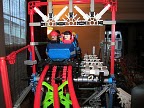Many people are known to use Pledge to lube their track. It is most likely that these people think they can decrease the frictional forces that occur between the track and the wheels. I'd like to point out what really happens when wheels roll over a track. First I will talk briefly about three different types of friction.
Static friction
Static friction, also known as stiction, is the friction that occurs when the relative velocity between two objects is zero. Whenever you try to push a heavy object across a flat and horizontal surface, the minimal force to get the object moving is the static friction. If you push with less force, the object won't move and you are just wasting your time.
Kinetic friction
When you push with more force and the object starts moving, the relative velocity between both objects becomes non-zero and the friction becomes kinetic. Kinetic friction is usually smaller than static friction, which you can see by the decrease in needed force to keep the object moving after pushing it out of its initial spot.
Rolling resistance
This is a special type of friction and actually it consists of two types: kinetic friction between the two objects and the deformation of the two objects.
Ideally the relative velocity between the wheel's surface and the track is zero. When this is not the case, the wheel slips over the track. If this would happen to your car, the friction would become kinetic instead of static and you know that this is usually a decrease in friction. In other words: you lose grip. Now you may think: kinetic friction is less friction than static energy, then why would I want to keep the friction static??? Think about this important formula from physics: W=F*s. A force times the length over which it is applied is equal to the work (energy!) done by the force. If you push an object with 100 Newton over a length of 10 meters, you use an energy of 1000 Joule. When friction is static, the length over which the frictional force is applied is zero! No energy is lost to static friction! This in contrast to kinetic friction, which does cost energy, since the frictional force is applied over a non-zero distance. So we would not want our wheels to slip, since it costs energy!
Deformation of the objects is the other part of rolling resistance. Unless both the wheels and track are infinitely stiff, both will deform under the pressure of the G-forces involved in roller coasters. You probably know that, in the case of Screamin' Serpent styled K'NEX roller coasters, more cross ties mean less friction. When you remove cross ties, the track is more likely to bend / deform under the pressure of a train riding over it. This is also why we roller coaster builders like to add as many track-to-support connections as possible, to make the track stiffer. The wheels will also deform under the pressure. You can hardly notice this, but when you think about the fact that these wheels are also plastic, you will be likely to believe this.
Lube your wheels, not the track
From the previous paragraphs we know that slippage is unwanted and the stiffer the wheels and track, the better. Making the track stiffer is something that is up to you and is not in the scope of this thread. Making the wheels stiffer may be an interesting idea for the future; replacing the plastic wheels by metal wheels (like CoasterDynamix has), but is also not in the scope of this thread. We're talking about preventing slippage between the wheels and the track. But let's not forget the friction between the wheels and their axles, which is what we use lube for.
Why not the track?
When lubing the track, what will be the benefit? Here is a nice experiment for you to do: spray Pledge all over your floor (or stair case, if you want to kill people...). Make sure the floor is a smooth surface, so the effect will be clearly visible. Now walk over the floor and you will be likely to slip and hit the floor.
Instead of lubing your track, just keep it clean and smooth, but do not put any Pledge or other lubrication on it. Either way you'll make the track more sticky or you will introduce slippage. I use a damp cloth to clean the track.
Then what do I lube?
Now if we do not lube the track, because it can work against us, and other methods of reducing friction (stiffening the track) do not involve lubing, what do we lube??? The axles of the wheels! These axles are stationary, thus they do not rotate, they are clamped inside the wheel assembly of the train. The wheels, however, rotate. This means that the relative velocity between a wheel and its axle is always non-zero, causing kinetic friction. This results in energy loss, which we can reduce in two ways. One way is a trivial one and that is to stop the train from moving. Of course that is not what we want, so we resort to the second method: lube! By lubing the contact area between the wheel and the axle, the kinetic friction will become smaller, resulting in less energy loss and thus giving us the ability to make longer layouts!
In the lubrication thread by Ickus you can read what to use as lubrication and what not. He also shows how he applies his lubrication, with a pen oiler. From this point on, this thread will be based on my personal experience and it will divert from Ickus' thread. Personally I use silicon spray, whatever brand is okay for me, as long as it is silicon-based. It works great for me. Of course I do not apply this to the track, it is only used for the wheels. Now some people disassemble their trains to lube the axles, since they do not want lube on their wheels. Others, like Ickus, use a pen oiler to make sure the lube is applied only to the axle. Personally I do not disassemble my trains for lubing, nor do I use a pen oiler. I simply spray every wheel a fraction of a second. This way the contact area between the wheels and the axles is lubed. Yes, the contact area between the wheels and the track is also lubed this way and this thread just said this is unwanted! That is why my trains always do a couple of test runs before reaching optimal speed. By doing so, the silicon spray on the wheels (not the axles, I clearly mean the outside of the wheels) is removed from them. There is the possibility of certain spots of the track becoming shiny, meaning that there is silicon spray in that spot. In that case I use a damp cloth to clean that part of the track.
Why do I not disassemble my trains for lubing? It is too much effort and it can easily be done the way I do it. Why do I not use a pen oiler? I have not used it before and I am okay with my current lubing method.
This was my story about how I lube my trains and why I do it this way. I also explained how friction in K'NEX roller coasters works and why you should not lube your track.
























